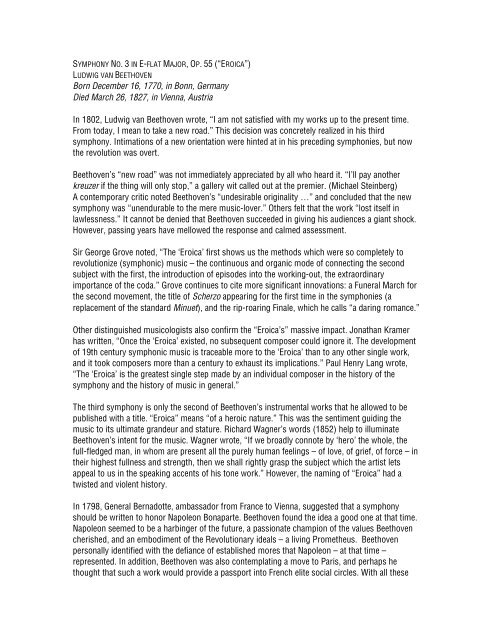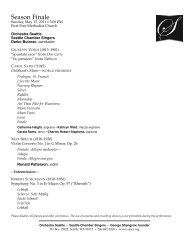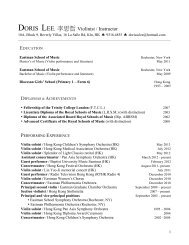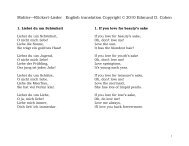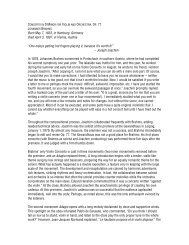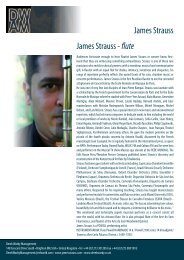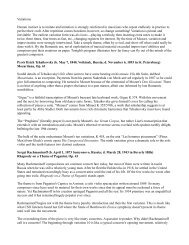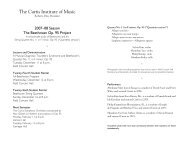SYMPHONY NO. 3 IN E-FLAT MAJOR, OP. 55 (“E ... - InstantEncore
SYMPHONY NO. 3 IN E-FLAT MAJOR, OP. 55 (“E ... - InstantEncore
SYMPHONY NO. 3 IN E-FLAT MAJOR, OP. 55 (“E ... - InstantEncore
Create successful ePaper yourself
Turn your PDF publications into a flip-book with our unique Google optimized e-Paper software.
<strong>SYMPHONY</strong> <strong>NO</strong>. 3 <strong>IN</strong> E-<strong>FLAT</strong> <strong>MAJOR</strong>, <strong>OP</strong>. <strong>55</strong> (<strong>“E</strong>ROICA”)<br />
LUDWIG VAN BEETHOVEN<br />
Born December 16, 1770, in Bonn, Germany<br />
Died March 26, 1827, in Vienna, Austria<br />
In 1802, Ludwig van Beethoven wrote, “I am not satisfied with my works up to the present time.<br />
From today, I mean to take a new road.” This decision was concretely realized in his third<br />
symphony. Intimations of a new orientation were hinted at in his preceding symphonies, but now<br />
the revolution was overt.<br />
Beethoven’s “new road” was not immediately appreciated by all who heard it. “I’ll pay another<br />
kreuzer if the thing will only stop,” a gallery wit called out at the premier. (Michael Steinberg)<br />
A contemporary critic noted Beethoven’s “undesirable originality …” and concluded that the new<br />
symphony was “unendurable to the mere music-lover.” Others felt that the work “lost itself in<br />
lawlessness.” It cannot be denied that Beethoven succeeded in giving his audiences a giant shock.<br />
However, passing years have mellowed the response and calmed assessment.<br />
Sir George Grove noted, “The ‘Eroica’ first shows us the methods which were so completely to<br />
revolutionize (symphonic) music – the continuous and organic mode of connecting the second<br />
subject with the first, the introduction of episodes into the working-out, the extraordinary<br />
importance of the coda.” Grove continues to cite more significant innovations: a Funeral March for<br />
the second movement, the title of Scherzo appearing for the first time in the symphonies (a<br />
replacement of the standard Minuet), and the rip-roaring Finale, which he calls “a daring romance.”<br />
Other distinguished musicologists also confirm the <strong>“E</strong>roica’s” massive impact. Jonathan Kramer<br />
has written, “Once the ‘Eroica’ existed, no subsequent composer could ignore it. The development<br />
of 19th century symphonic music is traceable more to the ‘Eroica’ than to any other single work,<br />
and it took composers more than a century to exhaust its implications.” Paul Henry Lang wrote,<br />
“The ‘Eroica’ is the greatest single step made by an individual composer in the history of the<br />
symphony and the history of music in general.”<br />
The third symphony is only the second of Beethoven’s instrumental works that he allowed to be<br />
published with a title. <strong>“E</strong>roica” means “of a heroic nature.” This was the sentiment guiding the<br />
music to its ultimate grandeur and stature. Richard Wagner’s words (1852) help to illuminate<br />
Beethoven’s intent for the music. Wagner wrote, “If we broadly connote by ‘hero’ the whole, the<br />
full-fledged man, in whom are present all the purely human feelings – of love, of grief, of force – in<br />
their highest fullness and strength, then we shall rightly grasp the subject which the artist lets<br />
appeal to us in the speaking accents of his tone work.” However, the naming of <strong>“E</strong>roica” had a<br />
twisted and violent history.<br />
In 1798, General Bernadotte, ambassador from France to Vienna, suggested that a symphony<br />
should be written to honor Napoleon Bonaparte. Beethoven found the idea a good one at that time.<br />
Napoleon seemed to be a harbinger of the future, a passionate champion of the values Beethoven<br />
cherished, and an embodiment of the Revolutionary ideals – a living Prometheus. Beethoven<br />
personally identified with the defiance of established mores that Napoleon – at that time –<br />
represented. In addition, Beethoven was also contemplating a move to Paris, and perhaps he<br />
thought that such a work would provide a passport into French elite social circles. With all these
issues in mind, Beethoven dedicated the work to the great warrior.<br />
That dedication was short-lived. On May 2, 1804, when Napoleon assumed the title Emperor,<br />
Beethoven flew into a rage, saying, “He is nothing but an ordinary mortal! He will trample all the<br />
rights of men underfoot to indulge his ambition….” After his screams, Beethoven tore the title page<br />
in half and threw it on the ground. Napoleon’s name was thus forever deleted from the original<br />
dedication. The dedication evolved into “Sinfonia Eroica, Composed to Celebrate the Memory of a<br />
Great Man.” Beethoven’s anger against Napoleon was enduring. When he heard of a later<br />
Napoleonic victory, he declared, “It is a pity that I do not understand the art of war as well as I do<br />
the art of music. Then I would conquer him!”<br />
The “new road” Beethoven contemplated in his music begins at once. The first movement plunges<br />
headlong into the substance of the music, eliminating a customary introduction. Two sharp<br />
staccato chords roar from the orchestra, followed by the first rocking theme, outlining the E flat<br />
triad. Its simplicity is momentary; quickly the theme coils into increasing tension through tight<br />
repetitions, seeking a resolution from its first strange landing point on a C sharp. Our sense of tonal<br />
security is immediately at risk. Additional agitation is added when syncopated accents interrupt a<br />
lush cello melody. Only small respites are granted as the music insists on its turbulent course,<br />
shrieking with large discords before the huge development section.<br />
This development section lasts for 250 measures, the size of entire single first movements of<br />
certain classical symphonies! The development continues the behavior of harmonic shocks and<br />
rhythmic syncopations. A recapitulation (hinted at by a horn in another key before beginning proper<br />
in the violins) not only repeats the exposition but introduces even more ideas and more harmonic<br />
adventures. To many contemporaries, the traditional symphonic form seemed to be growing wildly<br />
out of control, but Beethoven was relentless. Finally, a huge coda (140 measures) brings the first<br />
movement to a close.<br />
The second movement is titled Marcia funebre (Funeral March). Heroic grief is held in tight control.<br />
“There is no pessimistic whining, no luxury of self-pity. It is an epic lamentation over heroes slain<br />
in the defense of everyone’s freedom.” (Edward Downes) The march begins in violins. An oboe<br />
repeats the theme, and a melancholy tune emerges again from the strings. A trio led by oboe and<br />
flute prepares us for the stunning conclusion: a giant, dense fugue built on the march theme.<br />
The third movement is marked Scherzo: allegro vivace. The music is bursting with optimism,<br />
energy and a certain madness. The trio offers fine opportunities for beautiful horn playing. Then the<br />
madness is revived, ending in a small coda.<br />
The fourth movement, Finale: allegro molto, continues the liveliness of the preceding music, but it<br />
also marks new ground. Michael Steinberg has observed, “A final and startling newness in the<br />
‘Eroica’ is the way the center of gravity is shifted from the first movement to the last.” First and<br />
second violins pluck a soft angular tune that later is combined with the presentation of Beethoven’s<br />
“Prometheus” theme. (This theme had been used three times previously by the composer: in a<br />
group of contradances, in the finale of the ballet, and in the <strong>“E</strong>roica Piano Variations.”) In the final<br />
movement, variations are exquisitely crafted on this theme, ending with a tight fugato (imitative<br />
passage). The music then rushes powerfully to its close, a series of heavy, crunching and affirming<br />
chords.
The third symphony always remained dear to the composer. After completing eight symphonies,<br />
Beethoven was asked by his poet friend, Christoff Kuffner, which symphony was his favorite, and<br />
he answered simply and without hesitation, “The Eroica.”<br />
Jun Märkl conducted the orchestra’s last performances of Beethoven’s third symphony in June<br />
2004.


